CloudFormation
- CloudFormation is a declarative way of outlining your AWS Infrastructure, for any resources (most of them are supported)
- For example, within a CloudFormation template, you say:
- I want a security group
- I want two EC2 instances using this security group
- I want two Elastic IPs for these EC2 instances
- I want an S3 bucket
- I want a load balancer (ELB) in front of these EC2 instances
- Then CloudFormation creates those for you, in the right order, with the exact configuration that you specify
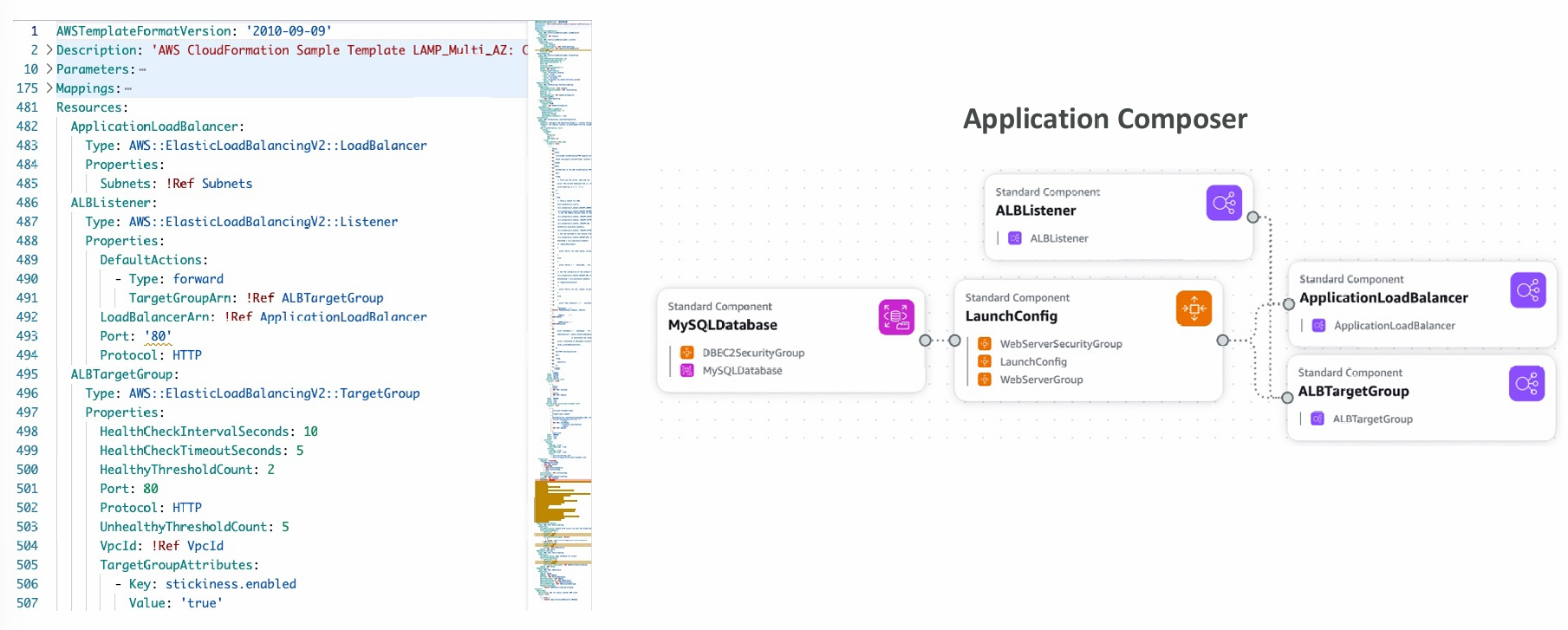
Benefits of AWS CloudFormation
- Infrastructure as code
- No resources are manually created, which is excellent for control
- The code can be version controlled for example using Git
- Changes to the infrastructure are reviewed through code
- Cost
- Each resources within the stack is tagged with an identifier so you can easily see how much a stack costs you
- You can estimate the costs of your resources using the CloudFormation template
- Savings strategy: In Dev, you could automation deletion of templates at 5 PM and recreated at 8 AM, safely
- Productivity
- Ability to destroy and re-create an infrastructure on the cloud on the fly
- Automated generation of Diagram for your templates!
- Declarative programming (no need to figure out ordering and orchestration)
- Separation of concern: create many stacks for many apps, and many layers. Ex:
- VPC stacks
- Network stacks
- App stacks
- Don’t re-invent the wheel
- Leverage existing templates on the web!
- Leverage the documentation
How CloudFormation Works
- Templates must be uploaded in S3 and then referenced in CloudFormation
- To update a template, we can’t edit previous ones. We have to reupload a new version of the template to AWS
- Stacks are identified by a name
- Deleting a stack deletes every single artifact that was created by CloudFormation

Templates
- Manual way
- Editing templates in Application Composer or code editor
- Using the console to input parameters, etc…
- We’ll mostly do this way in the course for learning purposes
- Automated way
- Editing templates in a YAML file
- Using the AWS CLI (Command Line Interface) to deploy the templates, or using a Continuous Delivery (CD) tool
- Recommended way when you fully want to automate your flow
Building Blocks
- Template’s Components
- AWSTemplateFormatVersion – identifies the capabilities of the template “2010-09-09”
- Description – comments about the template
- Resources (MANDATORY) – your AWS resources declared in the template
- Parameters – the dynamic inputs for your template
- Mappings – the static variables for your template
- Outputs – references to what has been created
- Conditionals – list of conditions to perform resource creation
- Template’s Helpers
- References
- Functions
Resources
- Resources are the core of your CloudFormation template (MANDATORY)
- They represent the different AWS Components that will be created and configured
- Resources are declared and can reference each other
- AWS figures out creation, updates and deletes of resources for us
- There are over 700 types of resources (!)
- Resource types identifiers are of the form:
service-provider::service-name::data-type-name
Parameters
- Parameters are a way to provide inputs to your AWS CloudFormation template
- They’re important to know about if:
- You want to reuse your templates across the company
- Some inputs can not be determined ahead of time
- Parameters are extremely powerful, controlled, and can prevent errors from happening in your templates, thanks to types
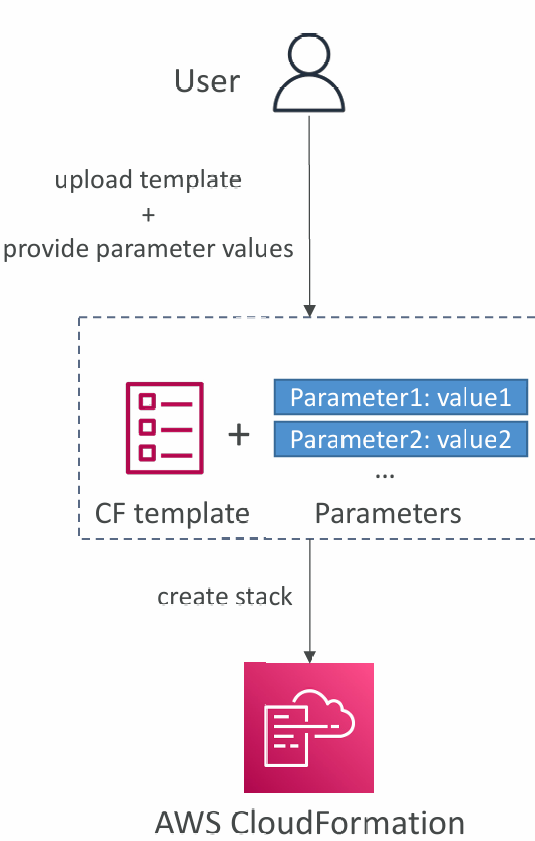
- Ask yourself this:
- Is this CloudFormation resource configuration likely to change in the future?
- If so, make it a parameter
- You won’t have to re-upload a template to change its content
Parameters Settings
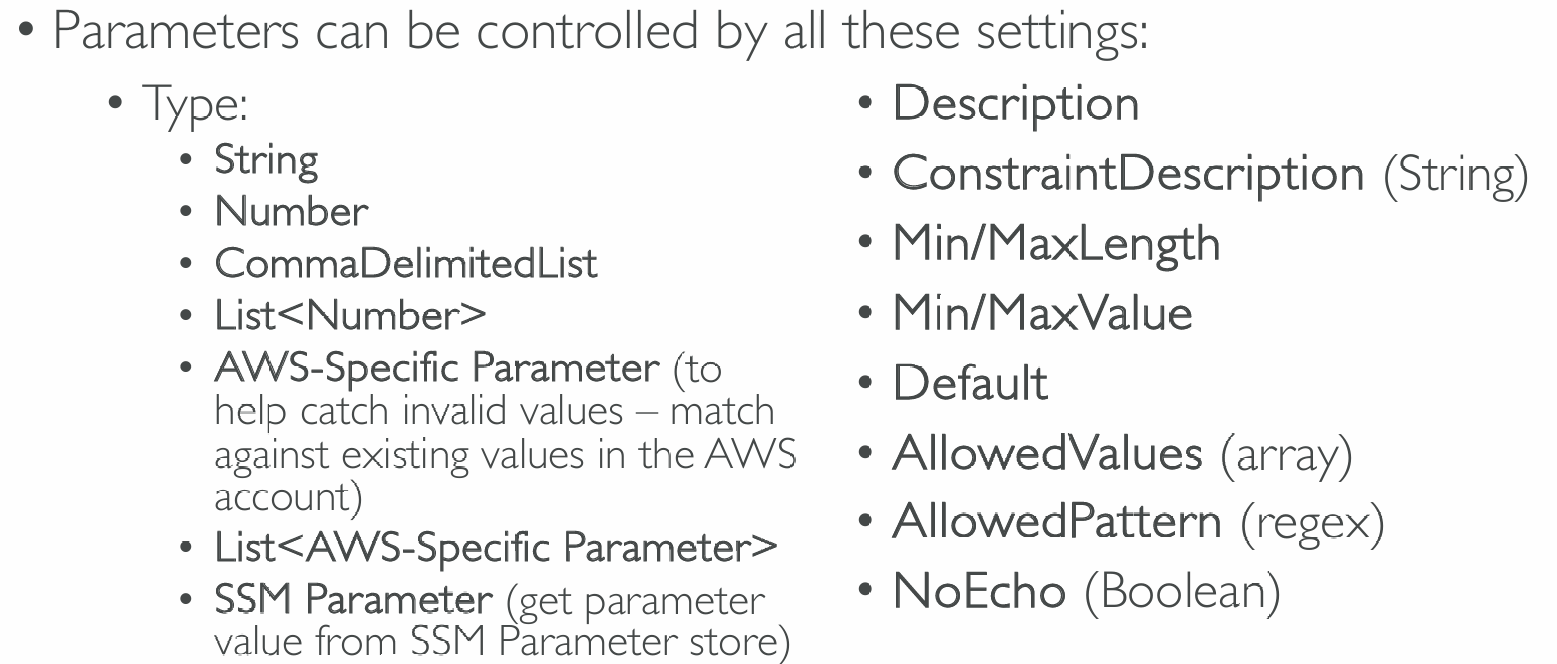
Example
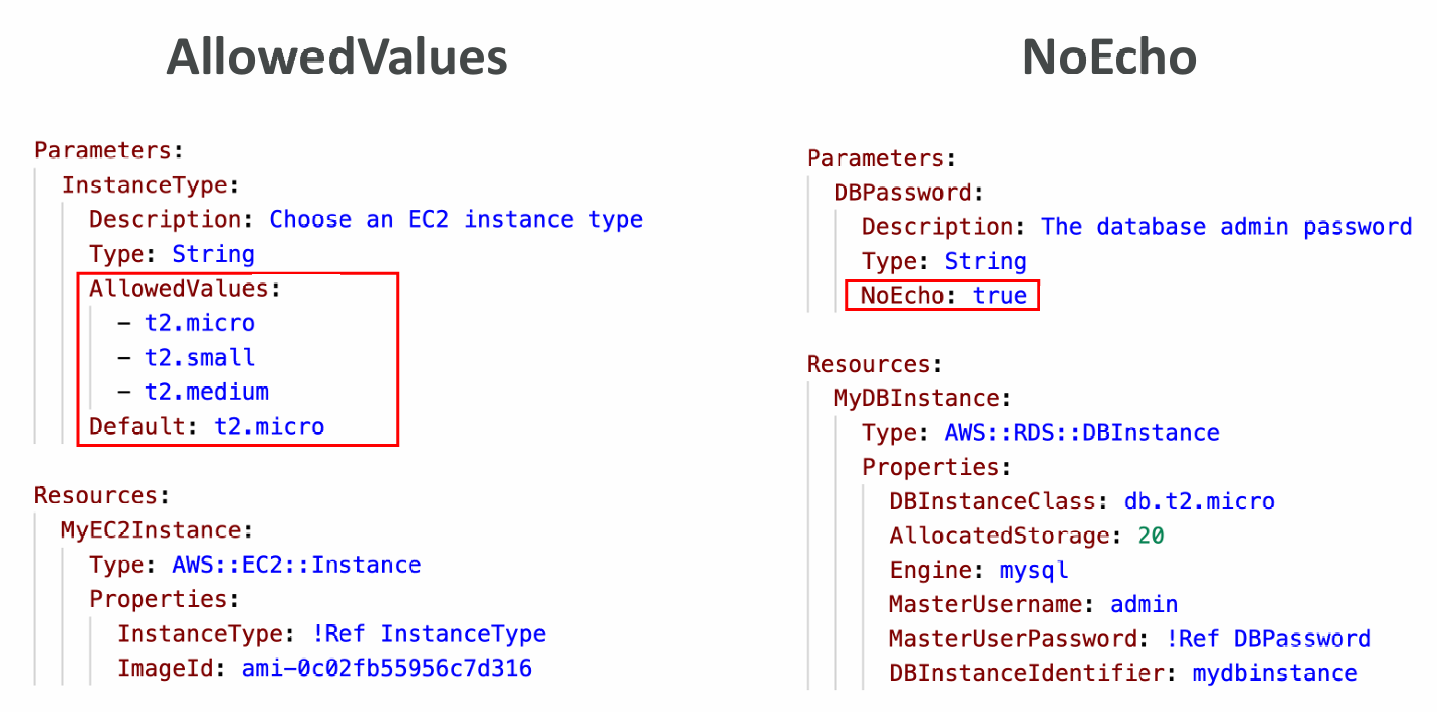
Referencing parameters
- The Fn::Ref function can be leveraged to reference parameters
- Parameters can be used anywhere in a template
- The shorthand for this in YAML is !Ref
- The function can also reference other elements within the template
Pseudo Parameters
- AWS offers us Pseudo Parameters in any CloudFormation template
- These can be used at any time and are enabled by default
- Important pseudo parameters:

Mappings
- Mappings are fixed variables within your CloudFormation template
- They�’re very handy to differentiate between different environments (dev vs prod), regions (AWS regions), AMI types…
- All the values are hardcoded within the template
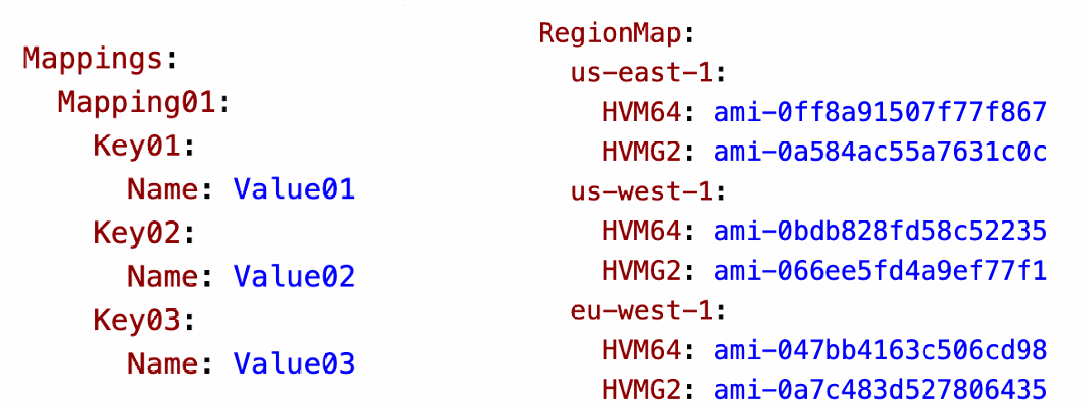
Accessing Mapping Values (Fn::FindInMap)
- We use Fn::FindInMap to return a named value from a specific key
- !FindInMap [ MapName, TopLevelKey, SecondLevelKey ]

Mappings vs. Parameters
- Mappings are great when you know in advance all the values that can be taken and that they can be deduced from variables such as
- Region
- Availability Zone
- AWS Account
- Environment (dev vs prod)
- etc…
- They allow safer control over the template
- Use parameters when the values are really user specific
Outputs
- The Outputs section declares optional outputs values that we can import into other stacks (if you export them first)!
- You can also view the outputs in the AWS Console or in using the AWS CLI
- They’re very useful for example if you define a network CloudFormation, and output the variables such as VPC ID and your Subnet IDs
- It’s the best way to perform some collaboration cross stack, as you let expert handle their own part of the stack
- Creating a SSH Security Group as part of one template
- We create an output that references that security group

Cross-Stack Reference
- We then create a second template that leverages that security group
- For this, we use the Fn::ImportValue function
- You can’t delete the underlying stack until all the references are deleted
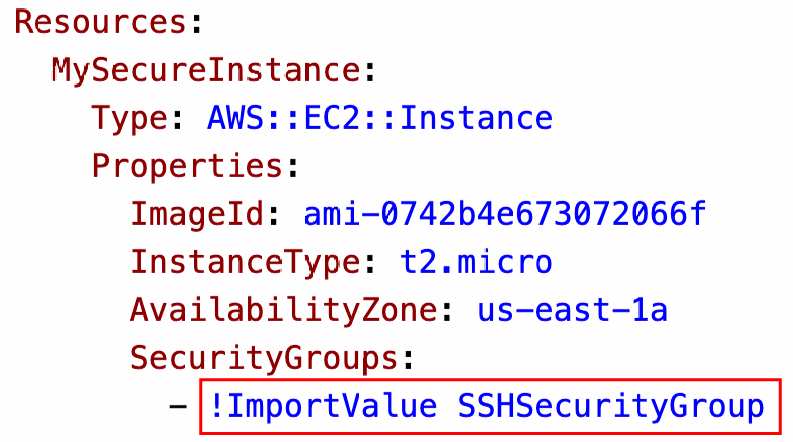
Conditions
- Conditions are used to control the creation of resources or outputs based on a condition
- Conditions can be whatever you want them to be, but common ones are:
- Environment (dev / test / prod)
- AWS Region
- Any parameter value
- Each condition can reference another condition, parameter value or mapping
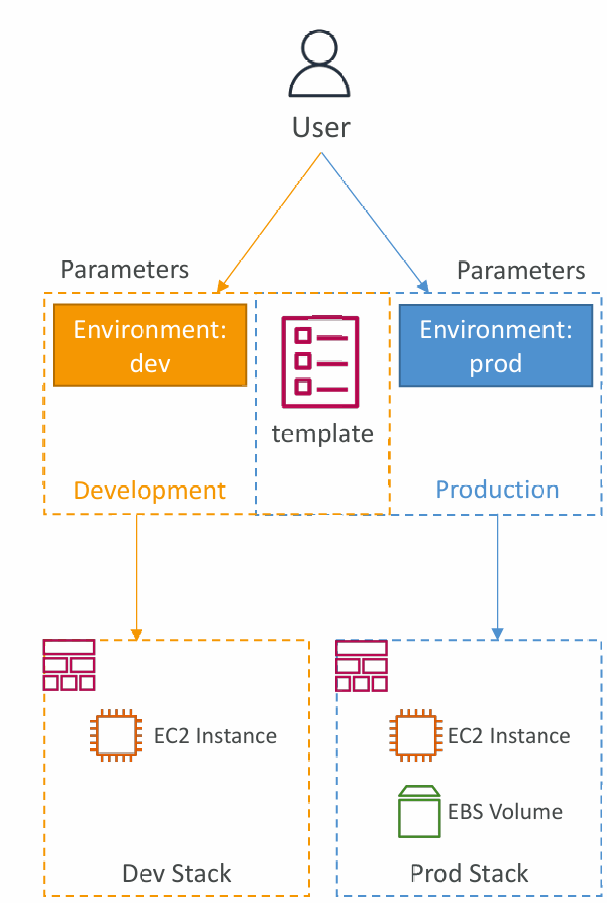
How to define a Condition
Conditions:
CreateProdResources: !Equals [!Ref EnvType, prod]
- The logical ID is for you to choose. It’s how you name condition
- The intrinsic function (logical) can be any of the following:
- Fn::And
- Fn::Equals
- Fn::If
- Fn::Not
- Fn::Or
How to use a Condition
Conditions can be applied to resources / outputs / etc…
Resources:
MountPoint:
Type: AWS::EC2::VolumeAttachment
Condition: CreateProdResources
Intrinsic Functions
- Ref
- Fn::GetAtt
- Fn::FindInMap
- Fn::ImportValue
- Fn::Base64
- Condition Functions (Fn::If, Fn::Not, Fn::Equals, etc…)
Fn::Ref
- The Fn::Ref function can be leveraged to reference
- Parameters – returns the value of the parameter
- Resources – returns the physical ID of the underlying resource (e.g., EC2 ID)
- The shorthand for this in YAML is !Ref
Resources:
DBSubnet1:
Type: AWS::EC2::Subnet
Properties:
VpcId: !Ref MyVPC
Fn::GetAtt
- Attributes are attached to any resources you create
- To know the attributes of your resources, the best place to look at is the documentation
- Example: the AZ of an EC2 instance!

Fn::FindInMap
- We use Fn::FindInMap to return a named value from a specific key
!FindInMap [ MapName, TopLevelKey, SecondLevelKey ]
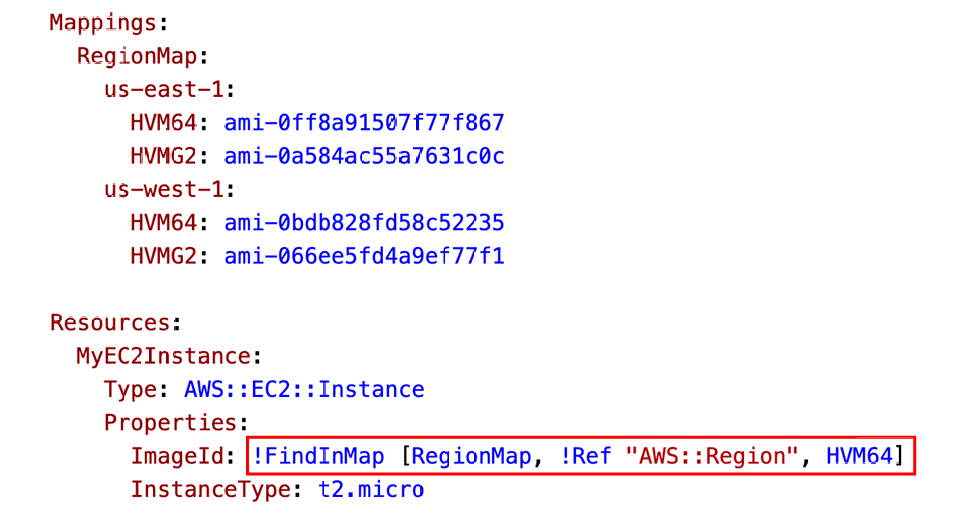
Fn::ImportValue
- Import values that are exported in other stacks
- For this, we use the Fn::ImportValue function
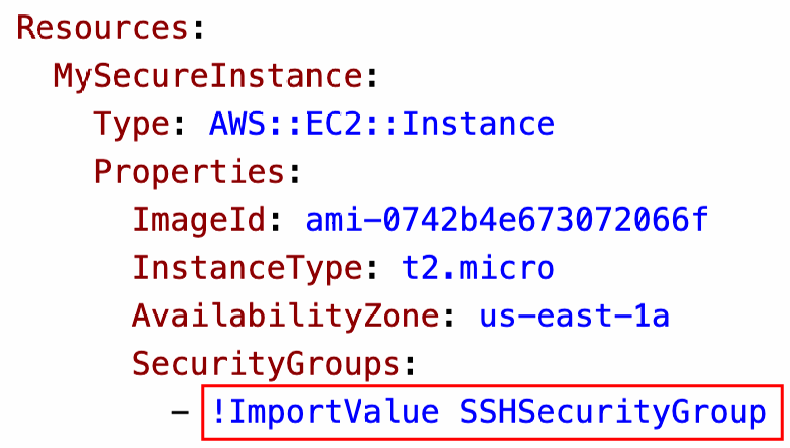
Fn::Base64
- Convert String to it’s Base64 representation
!Base64 "ValueToEncode"
- Example: pass encoded data to EC2 Instance’s UserData property

Condition Functions
Conditions:
CreateProdResources: !Equals [!Ref EnvType, prod]
- The logical ID is for you to choose. It’s how you name condition
- The intrinsic function (logical) can be any of the following:
- Fn::And
- Fn::Equals
- Fn::If
- Fn::Not
- Fn::Or
Rollbacks
- Stack Creation Fails:
- Default: everything rolls back (gets deleted). We can look at the log
- Option to disable rollback and troubleshoot what happened
- Stack Update Fails:
- The stack automatically rolls back to the previous known working state
- Ability to see in the log what happened and error messages
- Rollback Failure? Fix resources manually then issue ContinueUpdateRollback API from Console
- Or from the CLI using continue-update-rollback API call
Service Role
- IAM role that allows CloudFormation to create/update/delete stack resources on your behalf
- Give ability to users to create/update/delete the stack resources even if they don’t have permissions to work with the resources in the stack
- Use cases:
- You want to achieve the least privilege principle
- But you don’t want to give the user all the required permissions to create the stack resources
- User must have iam:PassRole permissions
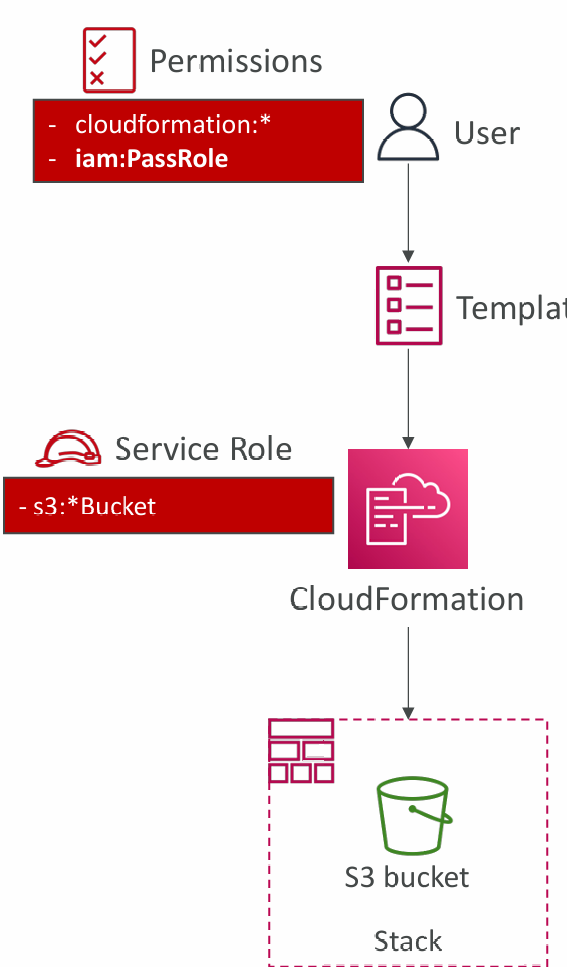
Capabilities
- CAPABILITY_NAMED_IAM and CAPABILITY_IAM
- Necessary to enable when you CloudFormation template is creating or updating IAM resources (IAM User, Role, Group, Policy, Access Keys, Instance Profile…)
- Specify CAPABILITY_NAMED_IAM if the resources are named
- CAPABILITY_AUTO_EXPAND
- Necessary when your CloudFormation template includes Macros or Nested Stacks (stacks within stacks) to perform dynamic transformations
- You’re acknowledging that your template may change before deploying
- InsufficientCapabilitiesException
- Exception that will be thrown by CloudFormation if the capabilities haven’t been acknowledged when deploying a template (security measure)
DeletionPolicy Delete
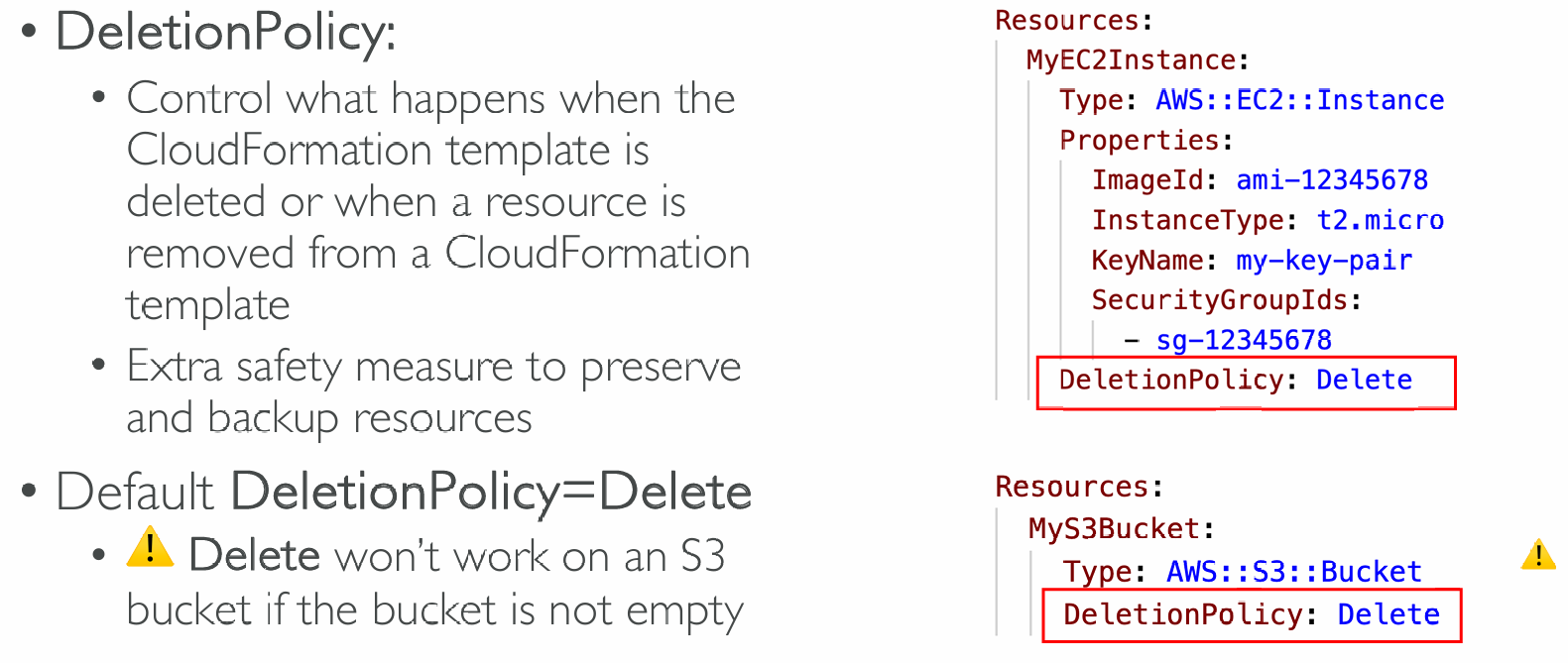
DeletionPolicy Retain
- Specify on resources to preserve in case of CloudFormation deletes
- Works with any resource
DeletionPolicy Snapshot
- Create one final snapshot before deleting the resource
- Examples of supported resources:
- EBS Volume, ElastiCache Cluster, ElastiCache ReplicationGroup
- RDS DBInstance, RDS DBCluster, Redshift Cluster, Neptune DBCluster, DocumentDB DBCluster
Stack Policies
- During a CloudFormation Stack update, all update actions are allowed on all resources (default)
- A Stack Policy is a JSON document that defines the update actions that are allowed on specific resources during Stack updates
- Protect resources from unintentional updates
- When you set a Stack Policy, all resources in the Stack are protected by default
- Specify an explicit ALLOW for the resources you want to be allowed to be updated
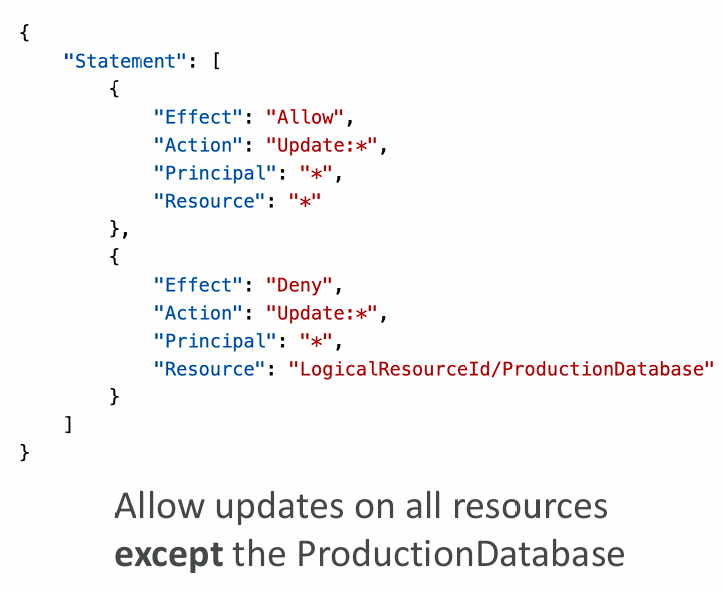
Termination Protection
- To prevent accidental deletes of CloudFormation Stacks, use TerminationProtection
Custom Resources
- Used to
- define resources not yet supported by CloudFormation
- define custom provisioning logic for resources can that be outside of CloudFormation (on-premises resources, 3rd party resources…)
- have custom scripts run during create / update / delete through Lambda functions (running a Lambda function to empty an S3 bucket before being deleted)
- Defined in the template using AWS::CloudFormation::CustomResource or Custom::MyCustomResourceTypeName (recommended)
- Backed by a Lambda function (most common) or an SNS topic
Definition
- ServiceToken specifies where CloudFormation sends requests to, such as Lambda ARN or SNS ARN (required & must be in the same region)
- Input data parameters (optional)

Example
Use Case: Delete content from an S3 bucket
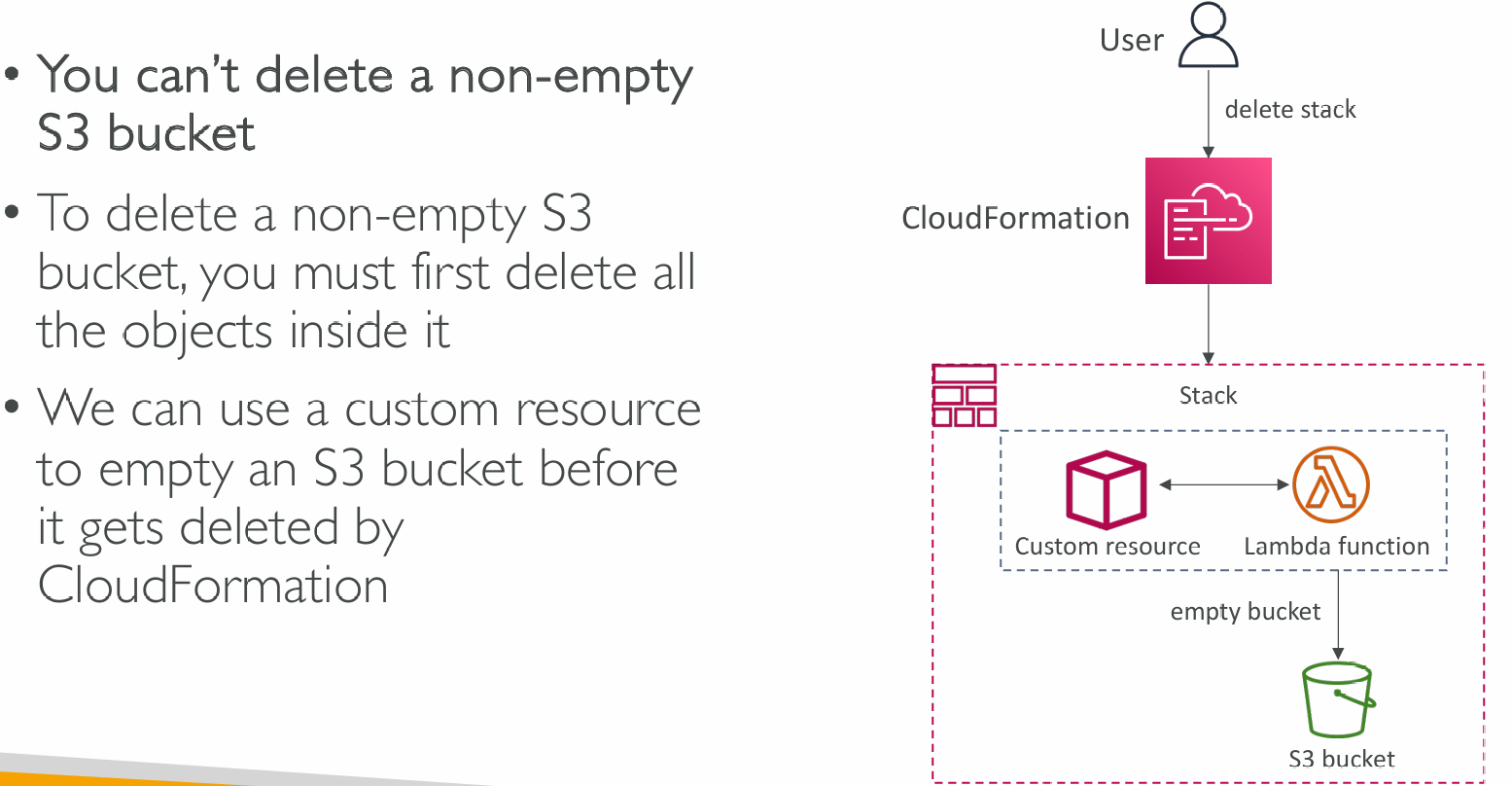
StackSets
- Create, update, or delete stacks across multiple accounts and regions with a single operation/template
- Target accounts to create, update, delete stack instances from StackSets
- When you update a stack set, all associated stack instances are updated throughout all accounts and regions
- Can be applied into all accounts of an AWS Organization
- Only Administrator account (or Delegated Administrator) can create StackSets